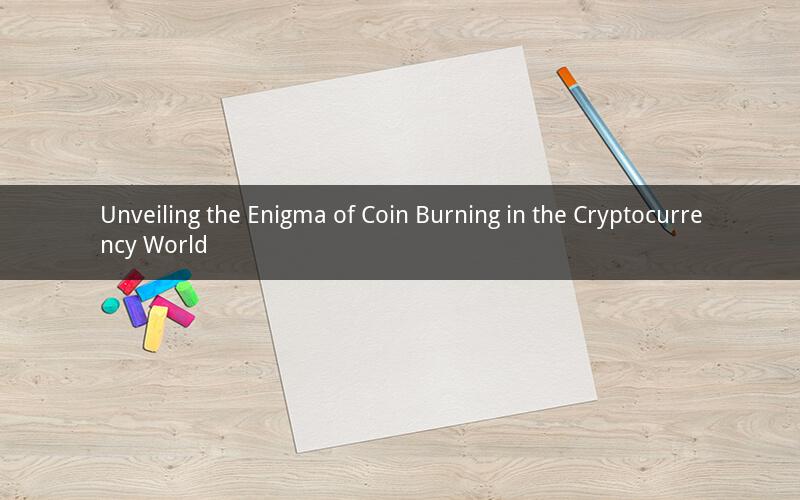
Introduction:
In the dynamic and ever-evolving world of cryptocurrencies, a term often tossed around is "coin burning." But what exactly is coin burning, and why is it such a significant concept in the crypto community? This article delves into the intricacies of coin burning, its implications, and its role in shaping the cryptocurrency landscape.
What is Coin Burning?
Coin burning, in the context of cryptocurrencies, refers to the permanent removal of a certain amount of coins from circulation. This process is often initiated by the cryptocurrency's developers or community members, with the aim of reducing the total supply of coins in the market. By doing so, the value of the remaining coins is enhanced, as the scarcity increases.
The primary objective of coin burning is to create a deflationary environment, where the value of the currency appreciates over time. This is in contrast to inflationary currencies, where the supply of money is continually increasing, leading to a decrease in purchasing power.
How Does Coin Burning Work?
The process of coin burning varies depending on the cryptocurrency in question. However, the general steps involved are as follows:
1. Identification of the coins to be burned: The first step is to identify the specific coins that will be removed from circulation. This could be a fixed amount or a percentage of the total supply.
2. Implementation of the burning mechanism: The developers or community members responsible for the cryptocurrency need to implement a mechanism to burn the coins. This could involve a smart contract or a specific algorithm.
3. Execution of the burning process: Once the mechanism is in place, the burning process is executed. This involves permanently deleting the coins from the blockchain, making them unavailable for use.
4. Verification and transparency: It is crucial for the coin burning process to be transparent and verifiable. This ensures that the community can trust the process and its effectiveness.
Why is Coin Burning Important?
1. Increased scarcity: By reducing the total supply of coins, coin burning creates a sense of scarcity. This can lead to an increase in the value of the remaining coins, as investors and holders become more confident in the long-term prospects of the cryptocurrency.
2. Deflationary environment: Coin burning fosters a deflationary environment, where the value of the currency appreciates over time. This can be attractive to investors looking for a store of value or a hedge against inflation.
3. Enhanced trust and credibility: A transparent and well-executed coin burning process can enhance the trust and credibility of a cryptocurrency. This can attract more investors and users, leading to increased adoption and market capitalization.
4. Incentivizing long-term holding: By reducing the supply of coins, coin burning incentivizes long-term holding. This is because the value of the coins is expected to increase over time, making it more beneficial for holders to keep their coins rather than sell them.
5. Counteracting potential inflation: In the event of inflationary pressures within a cryptocurrency ecosystem, coin burning can be used as a countermeasure to reduce the total supply and stabilize the value of the currency.
Case Studies: Successful Coin Burnings
1. Bitcoin (BTC): While Bitcoin does not have a built-in coin burning mechanism, it has seen a significant reduction in the total supply due to the halving events. These events occur approximately every four years and result in a 50% decrease in the reward for mining new blocks.
2. Litecoin (LTC): Litecoin has a built-in coin burning mechanism that automatically burns a portion of the transaction fees. This has contributed to the reduction of the total supply and the appreciation of the currency's value.
3. Dash (DASH): Dash has a unique coin burning mechanism called InstantSend, which allows users to burn a small fee when making transactions. This not only enhances privacy but also contributes to the reduction of the total supply.
4. Monero (XMR): Monero has a coin burning mechanism that burns a portion of the transaction fees. This helps in maintaining the privacy and security of the network while reducing the total supply.
5. Dogecoin (DOGE): Dogecoin has seen several instances of community-led coin burns, which have contributed to the reduction of the total supply and the appreciation of the currency's value.
Frequently Asked Questions (FAQs)
1. Q: Can coin burning lead to a complete depletion of the cryptocurrency's supply?
A: No, coin burning cannot lead to a complete depletion of the cryptocurrency's supply. The burning process is usually limited to a certain percentage or a fixed amount, ensuring that there is still a finite supply of coins.
2. Q: Is coin burning a guaranteed way to increase the value of a cryptocurrency?
A: While coin burning can contribute to an increase in value, it is not a guaranteed method. The value of a cryptocurrency is influenced by various factors, including market demand, technological advancements, and regulatory changes.
3. Q: Can coin burning be reversed?
A: No, coin burning is a permanent process. Once the coins are burned and removed from the circulation, they cannot be retrieved or reversed.
4. Q: Is coin burning legal in all countries?
A: The legality of coin burning varies depending on the country and its regulations. While some countries may have specific laws regarding cryptocurrency, others may not have any regulations in place.
5. Q: Can coin burning be used as a tool for market manipulation?
A: Yes, coin burning can be used as a tool for market manipulation. However, it is essential for the process to be transparent and verifiable to maintain the trust and credibility of the cryptocurrency.
Conclusion:
Coin burning is a significant concept in the cryptocurrency world, offering various benefits such as increased scarcity, a deflationary environment, and enhanced trust. By understanding the process and its implications, investors and users can make informed decisions regarding their investments in the crypto market.